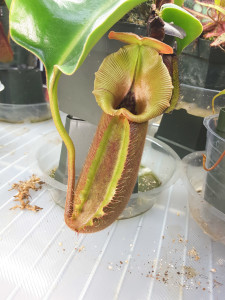
Nepenthes robcantleyi Cultivation and Care Notes
Nepenthes robcantleyi
Originally sold as “Nepenthes black truncata”
Pitcher plant species: Mindanao, Philippines
Altitude: 1800 meters above sea-level (~5900 feet)
Nepenthes robcantleyi has been extremely easy to care for since I received it from Predatory Plants as a small seedling. It pitchers on every leaf with no problems and regularly dries out completely without any ill effect. I would say that maintaining this species as a houseplant is very easy just like truncata. it has extremely strong thick leaves and pitchers and have no problems with lower humidity.Borneo exotics proprietor, Robert Cantley. was the one that discovered this species back in 1997. He had recieved permits to collect seeds of highland N. truncata on Mindanao. The plants that are circulated in cultivation are offspring from the seedlings originally collected by Cantley. King of Spades was a large male cultivar with dark colored pitchers that Rob found from those original seed and has used in breeding. Queen of Hearts is a female plant from the same original seed batch with more reddish pitchers and was the other parent of the Borne Exotics Nepenthes robcantleyi releases. They originally sold seedlings from this cross and now have over 500 individual clones maintained in tissue culture!
Without a doubt it is a very showy and spectacular species with consistent dark colors, hairy pitchers and easy growth habit is a must have for any collection. Many people have been underwhelmed by a lot of the original robcantleyi hybrids because they failed to pass their rich coloration on to the offspring. It seems however that Borneo Exotics have been able to find better companions that bring their own color and so other crosses I have seen more lately have been really nice, large and easy to grow with great color. A few that come to mind are N. robcantleyi x hamata, N. densiflora x robcantleyi, N. tobaica x robcantleyi, N. glandulifera x robcantleyi, N. burbidgeae x robcantleyi, and N. talangensis x robcantlyi.
Nepenthes robcantleyi Care and Infomation
- One of the most spectacular species to be discovered in recently.
- Was originally discovered in 1997 thought to be a black variation of truncata, it was formally described in 2001 as a distinct species.
- Very easy to grow in cultivation just like it relative Nepenthes truncata, N. robcantleyi does very well at household temperatures and humidity.
- Great option for windowsill growing and as an added bonus is that it is not a vining species, so althought the pitchers will become very large, the plants itself will not take over the grow-space.
- You will need room for the flower though, the longest recorded in the gemus can be over 2m long.
Find more information at Nepenthes robcantleyi wiki
If you want to learn more about cultivation of carnivorous plants, I highly recommend the comprehensive grow guide The Savage Garden, Revised: Cultivating Carnivorous Plants by Peter D,Amato. It is very easy to follow and reference and contains pictures and cultivation techniques for every genus of carnivorous plants.
If you want to learn more about Nepenthes or other pitcher plants, and see pictures of these spectacular species in the wild, I highly recommend reading Pitcher Plants of the Old World Volume One and Pitcher Plants of the Old World Volume Two
by Stewart McPherson it is over 1000 pages about nepenthes and cephalotus.

![Nepenthes robcantleyi "King of Spades" x "Queen of Hearts" [Feb 15, 2016]](https://youplants.com/wp-content/uploads/2016/03/Nepenthes-robcantleyi-whole-plant-feb15-2016-225x300.jpg)
![Same pitcher on N. robcantleyi now darkened . [Photo: March 12, 2016]](https://youplants.com/wp-content/uploads/2016/03/Nepenthes-robcantleyi-march4-2016-225x300.jpg)
Recent Comments